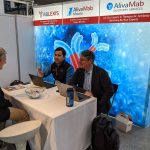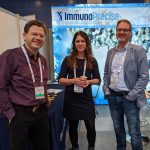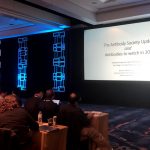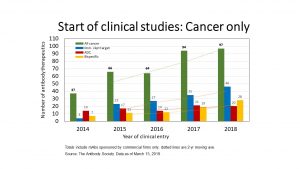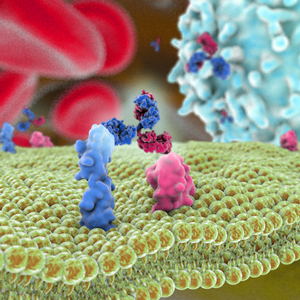Coronaviruses (CoVs) are enveloped positive-sense single-stranded RNA viruses that can cause highly lethal respiratory disease in humans, such as Middle East respiratory syndrome (MERS) and severe acute respiratory syndrome (SARS). The current coronavirus disease (COVID-19) pandemic is caused by the SARS-CoV-2 coronavirus. Infection in humans is initiated through exposure of the respiratory tract to the virus, which enters cells by binding angiotensin-converting enzyme 2 (ACE2) found on the cell surface.[1] Wrapp et al.[2] have shown that the SARS-CoV-2 spike protein binds to ACE2 with ~10- to 20-fold higher affinity than the spike protein of SARS–CoV, which is a coronavirus that caused an epidemic in 2002-2003.
An urgent and immediate need for knowledge about COVID-19 and for drugs to inhibit the virus and treat symptoms has existed since the disease started to spread in December 2019. To address this need, medical professionals have initiated numerous trials to identify key characteristics of the infections and the effects of investigational and approved drugs, including those used during the MERS and SARS outbreaks. As of March 19, 2020, clinicaltrials.gov already included ~115 studies related to COVID-19, with ~40 designed as observational studies or studies of diagnostics or devices, and ~75 designed to evaluate interventions such as antiviral drugs. Of the interventional studies, ~40 are currently recruiting patients, and the rest have not yet started recruiting. The earliest of these studies were started in China in late January 2020; additional studies may be listed on the Chinese clinical trials registry. Many studies are designed to produce results rapidly, which may greatly assist treatment of patients in the near future.
Effective in vitro inhibition of SARS-CoV-2 by remdesivir and chloroquine has been reported,[3] and numerous clinical studies are underway to determine the efficacy of these drugs as COVID-19 treatments.[4] Remdesivir (GS-5734, Gilead Sciences Inc) is an investigational monophosphoramidate prodrug of an adenosine analog with potent activity against an array of RNA virus families, including Filoviridae, Paramyxoviridae, Pneumoviridae, and Orthocoronavirinae, through the targeting of the viral RNA-dependent RNA polymerase. It was previously tested in humans with Ebola virus disease, and has demonstrated positive results in animal models of MERS.[5] Numerous clinical studies of the effects are remdesivir are ongoing, including:
- NCT04257656, started February 6, 2020 in China, with estimated enrollment of 453 patients and a primary completion date of April 3, 2020.
- NCT04252664, started February 12, 2020 in China, with estimated enrollment of 308 patients and a primary completion date of April 20, 2020.
- NCT04280705, started February 21, 2020 in the US, South Kora and Singapore, with estimated enrollment of 394 patients and a primary completion date of April 1, 2020.[6]
- NCT04292899, started March 6, 2020 in the US, South Kora and Singapore, with estimated enrollment of 400 patients and a primary completion date of May 2020.
- NCT04292730, started on March 15, 2020 in the US, South Kora and Singapore, with estimated enrollment of 600 patients and a primary completion date of May 2020.
The U.S. Army Medical Research and Development Command is sponsoring a study of remdesivir (NCT04302766) with enrollment limited to DoD-affiliated personnel (including active and reserve component service members, US civilian employees, contractors, other US personnel, and dependents of any age, as well as allied military forces and local nationals) who have a COVID-19 diagnosis and have been granted access to the medical facility.
Hydroxychloroquine, which is FDA-approved as a treatment for malaria, lupus and rheumatoid arthritis, appears to interfere with terminal glycosylation of ACE2 and is known to elevate endosomal pH, which may inhibit virus binding and subsequent infection.[7] Preliminary evidence from a small study in humans suggests that the combination of azithromycin and hydroxychloroquine is significantly more efficient for virus elimination.[8]
At least 3 clinical studies of the effects are hydroxychloroquine are ongoing:
- NCT04261517, started February 6, 2020 in Shanghai, with estimated enrollment of 30 patients and a primary completion date of August 2020.
- NCT04307693, started March 11, 2020 in Seoul, South Korea, with estimated enrollment of 150 patients and a primary completion date of May 2020.
- NCT04308668, started March 2020 in Minneapolis, Minnesota, United States, with estimated enrollment of 1500 patients and a primary completion date of May 2021.
On March 18, 2020, the World Health Organization announced that they are planning a multi-arm clinical trial that will evaluate the following drugs as treatments for COVID-19:
- Remdesivir;
- Hydroxychloroquine or chloroquine;
- Lopinavir-ritonavir (a combination of two HIV drugs marketed as Kaletra or Aluvia); and
- Lopinavir-ritonavir plus interferon beta.
Argentina, Bahrain, Canada, France, Iran, Norway, South Africa, Spain, Switzerland, and Thailand have offered study sites, and sites in other countries may be added in the future. The study, called SOLIDARITY, will use an adaptive design, which allows study arms to be modified, added or eliminated based on the results of ongoing data collection.[9] The lopinavir-ritonavir arms are included in the SOLIDARITY study despite the negative results of a clinical study of 199 hospitalized adult patients with severe COVID-19 in China, which showed no benefit from adding lopinavir–ritonavir treatment to standard care.[10] Further study is needed to understand whether factors such as the drug dose or patient characteristics (age, severity of disease, underlying medical conditions) affected the possibility of a treatment benefit.
In addition, positive results have been reported for the antiviral agent favipiravir (Avigan), which was evaluated in COVID-19 patients in clinical trials conducted in Wuhan and Shenzhen, China. Favipiravir was approved in 2014 in Japan for treatment of influenza, although use is limited because the drug may cause fetal deaths or deformities. Additional studies in COVID-19 are needed, however, results reported by Japanese health officials suggest the drug is less effective in patients with more severe symptoms.[11]
Other antiviral treatments are currently being evaluated, including anti-SARS-CoV-2 inactivated convalescent plasma (NCT04292340), as are therapies that can ameliorate symptoms of the disease, including anti-IL-6 sarilumab (NCT04315298) and anti-IL-6 receptor tocilizumab (NCT04306705, NCT04310228), which may reduce lung inflammation and improve lung function in COVID-19 patients.
Scientists are searching for new treatments and vaccines, which will be discussed in our upcoming posts.
1. Walls et al. Structure, Function, and Antigenicity of the SARS-CoV-2 Spike Glycoprotein. Cell. March 09, 2020. DOI:https://doi.org/10.1016/j.cell.2020.02.058
2. Wrapp et al. Cryo-EM structure of the 2019-nCoV spike in the prefusion conformation. Science 2020, 367, 1260-1263.
3. Wang et al. Remdesivir and chloroquine effectively inhibit the recently emerged novel coronavirus (2019-nCoV) in vitro. Cell Research 2020, 30, 269–271.
4. Food and Drug Administration, March 19, 2020. Coronavirus (COVID-19) Update: FDA Continues to Facilitate Development of Treatments.
5. National Institutes of Health, February 13, 2020. Remdesivir Prevents MERS Coronavirus Disease in Monkeys.
6. National Institutes of Health, February 25, 2020. NIH clinical trial of remdesivir to treat COVID-19 begins.
7. Vincent et al. Chloroquine is a potent inhibitor of SARS coronavirus infection and spread. Virology Journal 2005, 2, 69.
8. Gautret et al. (2020) Hydroxychloroquine and azithromycin as a treatment of COVID‐19: results of an open‐label non‐randomized clinical trial. International Journal of Antimicrobial Agents – In Press 17 March 2020 – DOI : 10.1016/j.ijantimicag.2020.105949
9. WHO Director-General’s opening remarks at the media briefing on COVID-19 – 18 March 2020.
10. Cao et al. A Trial of Lopinavir–Ritonavir in Adults Hospitalized with Severe Covid-19. New England Journal of Medicine. March 18, 2020. DOI: 10.1056/NEJMoa2001282.
11. Watanabe S, Chan M, Suzuki W. China says Japan-developed drug Avigan works against coronavirus. Nikkei Asian Review. March 18, 2020.
Coronavirus image from: CDC/ Alissa Eckert, MS; Dan Higgins, MAMS

